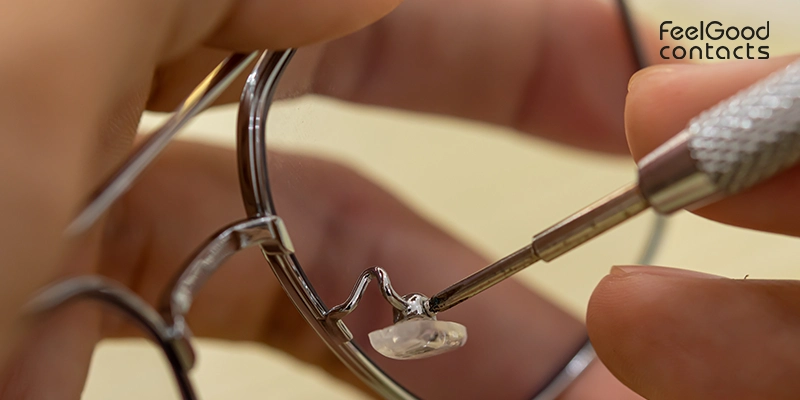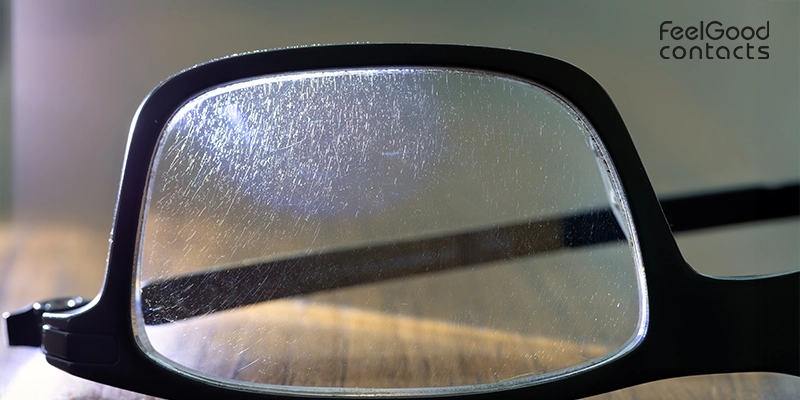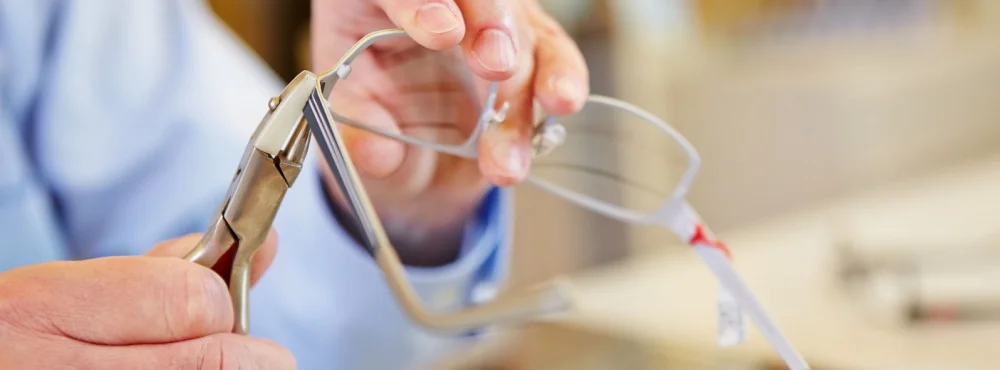Your prescription glasses are more than just a visual aid. They’re not just an investment, but a daily essential. Whether you rely on your eyeglasses for reading, driving, working, or all-day wear, they’re likely to be one of your most used and essential accessories. So, when something goes wrong, even a loose screw or a crooked frame can disrupt your routine and cause serious discomfort. While it’s best to take severely damaged eyewear to a professional, many common issues can be fixed with a few tools and a steady hand. Many common eyewear problems can be quickly and safely fixed at home with just a few basic tools and the right techniques.
In this comprehensive guide, we’ll walk you through step-by-step solutions for a range of issues to fix your glasses at home, from basic tightening to more advanced frame adjustments, so you can keep your glasses in top shape without leaving your house.
If one of the arms or temples breaks off

A broken or detached temple or arm can seem like a dealbreaker, but don’t panic. If the arm has fallen off due to a missing screw, it’s a straightforward fix:
- Align the hinge and replace the screw with a new one.
- If the arm is actually broken, a drop of superglue can serve as a temporary solution in emergencies. While it won't restore the frame to full strength, it can help you get through the day until you can replace the frame with a new one or seek professional repair.
If the glasses become loose or ill-fitted
If your glasses constantly slide down your nose, it could be due to loose temple arms or poorly positioned nose pads.
- Try gently bending the arms down and inward to create a snugger fit around your ears.
- If the frame they have has nose pads, you can also adjust the angle of those pads to improve the grip.
- For extra stability, especially during workouts or warm weather, consider adding silicone anti-slip sleeves to the temples.
In case your glasses feel unstable, or the arms seem to wobble when you open and close them, loose screws are likely to be the culprit. This is a very common issue caused by regular wear and movement. Most frames use tiny hinge screws that gradually loosen over time. You can fix this by gently tightening them with a precision screwdriver.
If the glasses look crooked or misaligned
When one lens is sitting higher than the other, or the frame is tilting to one side, your glasses are sitting unevenly on your face; such situations become quite uncomfortable and distract you from other work. This often happens if the frame has been bent out of shape.
- For plastic frames, you can use a hairdryer to gently heat the material and carefully adjust the arms or bridge. Make sure that while using the hairdryer, the hot air is not hitting the lenses.
- For metal frames, use light pressure to realign the structure. Always start by making small changes and keep checking the fit simultaneously to avoid damaging the frame.
If the nose pads go missing or feel uncomfortable

Missing adjustable nose pads can cause your glasses to sit unevenly and result in sore spots/marks on your nose. Replacing them is simple and inexpensive.
- Most pads are designed to snap or screw into place and can be easily swapped by snapping in by hand or a small screwdriver.
- If your nose pads are intact but uncomfortable, consider switching to nose pads made of softer materials, such as silicone, which are more flexible and gentler on the skin.
- You can also fine-tune the positioning of the metal nose pad arms for a more secure and comfortable fit.
If the lenses get scratched

Scratches on your lenses can be distracting, especially in bright light or when reading. Deep scratches require lens replacement and there is no quick fix around it.
One of the easiest ways to avoid scratches on your lenses is to opt for protective lenses coating, such as anti-scratch coating. Feel Good Contacts, you get a free scratch-resistant lens coating in all the lens packages, apart from the basic lens package.
If the lenses become loose or detached
A popped-out lens can look alarming, but it’s usually fixable at home, especially in plastic full-rim frames. Warm the frame slightly by using a hair dryer to make it more flexible, and gently press the lens back into place.
For metal frames, you may need to unscrew the lens rim slightly, insert the lens, and screw it back together. If a lens doesn’t stay in place, the frame may be warped or damaged and could need professional adjustment.
If the bridge is cracked or broken
The bridge is the part of the frame that rests on your nose and connects both lenses. If this area breaks, it definitely compromises the overall structure of your frame.
- For plastic frames, a dab of super glue or epoxy might hold the bridge together temporarily, but only as a temporary fix.
- For metal frames or serious fractures, the damage usually warrants professional repair or replacement.
Always check that the fit and balance are restored before continued use.
Can I get my glasses repaired or replaced on the NHS?
If you are concerned about the cost of getting your glasses repaired in the UK, the good news is that the NHS may cover that cost for you. Some people are eligible for help with the cost of repairing or replacing their glasses or contact lenses through NHS.
Children under 16 can get an NHS optical repair or replacement voucher, which helps towards the cost of replacing or repairing their glasses or contact lenses if they get lost or damaged.
If you're 16 or older, you're only eligible for help with repair or replacement costs if both of the following apply to you:
- You're eligible for an NHS optical voucher
- You have an illness that caused the loss of or damage to your glasses or contact lenses
Fixing your eyeglasses at home can be surprisingly simple and satisfying, especially when it saves you time, money, and a trip to the optician. By understanding the common issues and how to address them with basic tools, you can extend the life of your glasses and enjoy uninterrupted vision. Though fixing your glasses at home may look like a smarter and cheaper alternative, there will be times when it’s best to seek a professional fix for your glasses.

 Offers
Offers Account
Account
 Favorite
Favorite
 Basket
Basket

 OFFERS
OFFERS



















